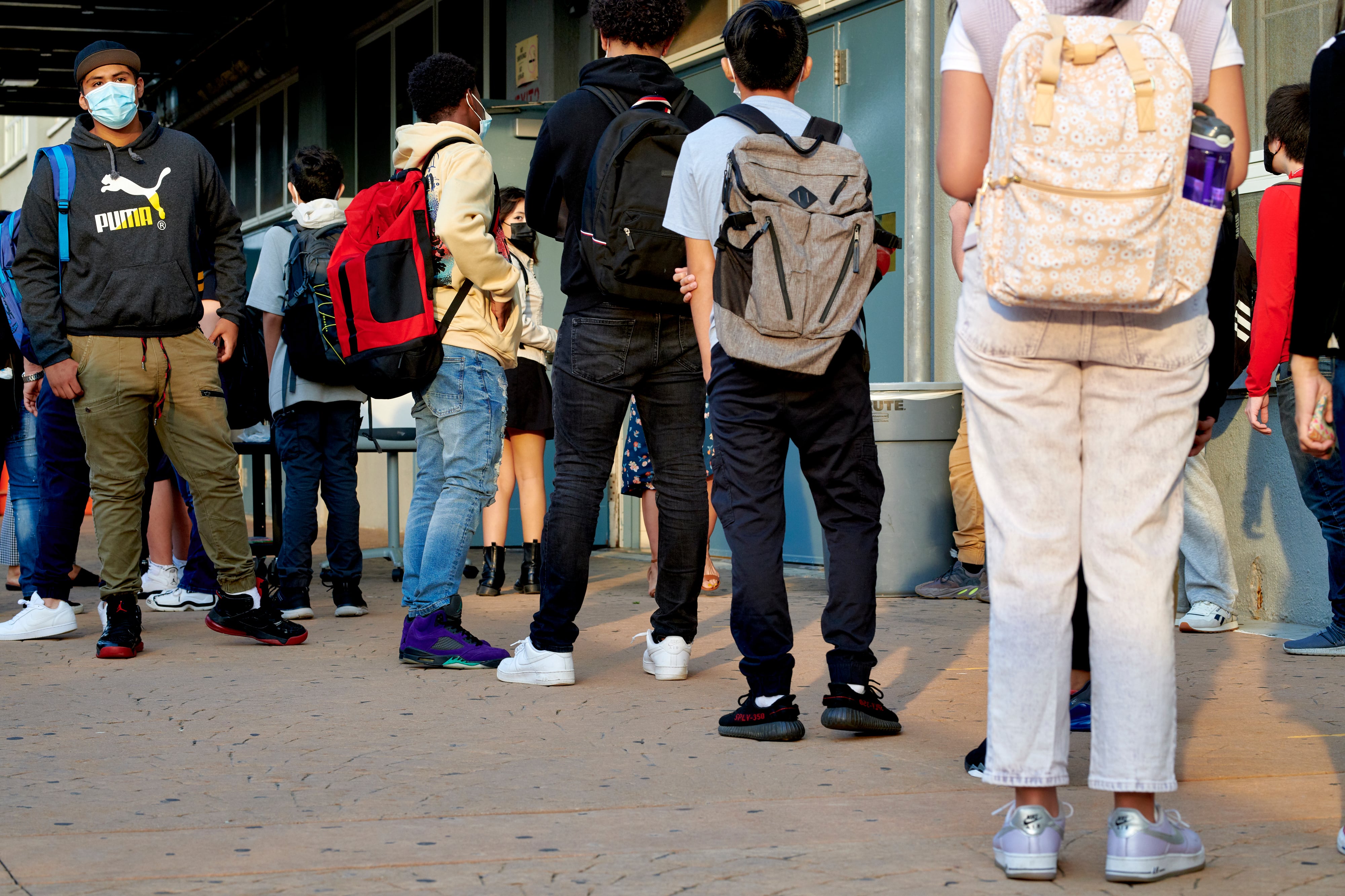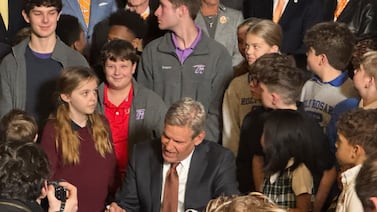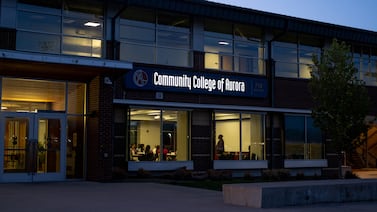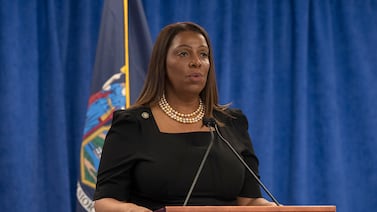With one week until winter break begins, New York City schools are feeling the strain of rising COVID-19 cases.
Principals are being reminded to get ready in case they need to close a classroom or even their entire school. The education department is also giving school leaders more leeway to act when positive cases are uncovered, as the city’s own rapid response team seems swamped with calls and emails.
This week, some school leaders received calls from their superintendents, and others got emails with a checklist of what’s needed in the event of remote learning, such as ensuring that students and staff have devices and logins.
After the messages sparked rumors that the city was gearing up for a wide-scale shut down, education department officials followed up on Thursday with superintendents and principals. In bold, underlined, red letters, the message said: “There is no plan for a systemwide school closure and pivot to remote learning.”
Amid signs of strain in the city’s Situation Room, the interagency rapid response team charged with conducting test-and-trace investigations in schools, officials said they will ramp up staffing. More than 500 people will work on the team, up from the current 275, according to the education department.
Some principals have been growing increasingly frustrated by the Situation Room’s delays in responding to positive cases, and many parents have been trying to fill the void of information and to make sense of confusing messages.
Dr. Jay Varma, a senior health advisor to the mayor, noted a record-breaking rise in cases in the city, doubling over three days to 7.8% as of Dec. 12.
“We’ve never seen this before,” he tweeted.
The number of school-age children testing positive has similarly shot upwards. On Monday, there were 502 new cases among those ages 5- to 17-years-old, according to state data. By Wednesday, there were 1,085 new positive tests.
The seven-day average of positive tests administered in schools stood at .87% on Dec. 15, Mayor Bill de Blasio said at a press conference on Thursday.
Concerns about omicron variant
Anna Bershteyn, an assistant professor of population health at New York University’s Grossman School of Medicine, said the upticks are consistent with the rapid spread of the omicron variant of the virus. According to the Centers for Disease Control and Prevention, the variant makes up about 13% of cases in the city.
“Honestly, omicron is so transmissible that it’s going to be really tough to prevent cases,” Bershteyn said.
She said the city should double down on the vaccines by encouraging every adult who works in schools to get a booster, while continuing to focus on increasing ventilation, social distancing, and cohorting students to limit exposure. Even though cases may rise, she said, “I don’t think it should come to closing schools.”
“I don’t think it’s feasible to prevent a rise in cases in school children, but it is feasible to make schools a safer place for children to be during the omicron wave, compared to schools being closed and children spending their days in the community,” Bershteyn said.
Education department officials continued to tout the safety of schools, citing that only 1% of classrooms were currently closed for quarantine.
“In anticipation of a winter increase in cases, we already started hiring more Situation Room staffers, expanded in-school testing to include teachers, fully vaccinated our staff and offered vaccinations to every student, and are constantly in communication with schools to reiterate the importance of closely following safety measures,” education department spokesperson Nathaniel Styer said in a statement.
Giving principals more autonomy
As rising cases tax the Situation Room, education department officials updated their guidance to principals on Thursday, now allowing school leaders to make the call on quarantines before getting the official go-ahead.
“If a positive case or intervention to a case comes late in the day, principals can call the close contacts of the case and ask them to stay home the next day and wait for further guidance from the Situation Room as long as they have seen a positive COVID test result in their school,” the email to school leaders said. “The principal does not need to wait for the Situation Room to give them the final intervention and letter package before communicating with those close contacts.”
That guidance, however, raised more questions than it answered, said Mark Cannizzaro, president of the Council for School Supervisors and Administrators, or CSA, the union representing principals and other school administrators. He criticized the education department for including the change in an email without working out details with the union, such as who else principals would have to notify if they quarantined individuals or what would happen if a principal’s decision differed from the Situation Room’s call.
“The cases are going up, and [the Situation Room] can’t handle the volume,” Cannizzaro said. “Someone may have made this change with the right intention — let the principals do this so they’re not waiting — but there should have been a meeting about it.”
Given the increased workload for principals this school year, the union recently worked out a deal with the education department to have department officials assume some of the duties of navigating quarantines. The transition was to occur on Dec. 6, but it hasn’t happened, Cannizzaro said.
Parent confusion and frustration
Brooklyn mom Meghan Groome expressed frustration with the Situation Room after both of her children’s schools recently had COVID cases. It took five days for the test-and-trace corps to notify her that her 3-year-old daughter at a city-run 3-K program should quarantine after a possible exposure.
“The idea that the Situation Room has been set up to provide parents with transparent and up-to-date information about COVID cases in their schools has fallen apart,” Groome said. “Parents are hearing rumors and getting information from other parents and teachers, but not actual confirmation from the Situation Room.”
Messages from the Situation Room have been confusing to Bronx mom Alycia Dingle, who received an email last week about her son’s school, the Bronx Center for Science and Mathematics, noting there were more than 20 cases, triggering a school closure. The emails kept coming daily. But it turned out that her son’s school was not closed — another school that shares the same building was. That co-located school, Eximius College Preparatory Academy, made up the bulk of positive cases: 20 out of the 23 found within the building.
The principal of Bronx Center for Science and Mathematics sent a clarifying email that their doors were still open. Still, whether parents were confused or scared, many kept their children home. Roughy 19% of students were absent Tuesday. By Wednesday, 26% remained home, according to public data.
As soon as Dingle saw the Situation Room email with the high case number, she had her son get tested — and he was positive. He now has a fever, cough and fatigue.
Dingle is worried he contracted the virus at school, where both schools share stairwells, the gym, and cafeteria.
About a month prior, Dingle’s daughter contracted the virus. Her school, Soundview Academy for Culture and Scholarship, had more than a dozen cases before Thanksgiving. Though the Situation Room conducted an investigation, they never closed the school.






